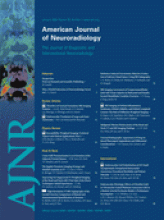Abstract
BACKGROUND AND PURPOSE: The extent of pial collateral formation during acute ischemic stroke has been shown to influence outcomes. This study examines whether angiographic assessment of pial collateral formation is predictive of hemorrhagic transformation following intra-arterial thrombolysis (IAT) for acute ischemic stroke.
MATERIALS AND METHODS: Rates of any hemorrhage and significant hemorrhage (>25 mL) were reviewed in 104 consecutive patients who underwent IAT following acute ischemic stroke. The influence of the anatomic extent of pial collateral formation on the rates of hemorrhage and significant hemorrhage relative to known predictors for hemorrhagic transformation (presenting systolic blood pressure, blood glucose level, platelet level, and National Institutes of Health Stroke Scale [NIHSS] score, history of diabetes, time to treatment, age, sex, occlusion site, and extent of reperfusion) was analyzed by using logistic regression models.
RESULTS: Rates of any hemorrhage and significant hemorrhage were 25.2% (26/104) and 9.7% (10/104), respectively. The rate of significant hemorrhage was 25.0% (8/32) in patients with poor pial collaterals and 2.78% (2/72) in those with good pial collaterals (P = .0004, Pearson correlation). The rate of any hemorrhage was also significantly higher in patients with poor pial collaterals (40.6% versus 18.1%; P = .0142, Pearson correlation). Logistic regression analyses revealed that pial collateral formation (odds ratio [OR] = 3.04), history of diabetes (OR = 4.83), platelets <200,000/μL (OR = 2.95), and time to treatment <3 hours (OR = 12.0) were statistically significant predictors of hemorrhage, whereas pial collateral formation (OR = 13.1) and platelets <200,000/μL (OR = 8.1) were statistically significant predictors of significant hemorrhage.
CONCLUSIONS: Poor pial collateral formation is associated with higher incidence and larger size of hemorrhage following IAT.
- Copyright © American Society of Neuroradiology












